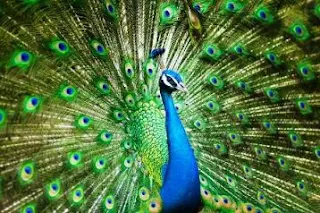National symbols of a country represent country's rich heritage as well as distinctive characteristic to the rest of the world. India has a number of official national symbols that are intrinsic to the Indian identity and heritage.
Indians across the world are proud of these National Symbols as they infuse a sense of pride and patriotism in every Indian's heart.
Here is the list of all national symbols of India including National identity elements:
National Flag:
Indians across the world are proud of these National Symbols as they infuse a sense of pride and patriotism in every Indian's heart.
Here is the list of all national symbols of India including National identity elements:
National Flag:
The National Flag is a horizontal tri-colour of deep saffron (kesaria) at the top, white in the middle and dark green at the bottom in equal proportion. The ratio of width of the flag to its length is two to three. In the center is a navy blue wheel with twenty-four spokes, known as the Ashoka Chakra.
The top saffron colour, indicates the strength and courage of the country. The white middle band indicates peace and truth with Dharma Chakra. The green shows the fertility, growth and auspiciousness of the land. Its design is that of the wheel which appears on the abacus of the Sarnath Lion Capital of Ashoka.
National Anthem:
The National Anthem of India Jana-gana-mana, composed originally in Bengali by Rabindranath Tagore, was adopted in its Hindi version by the Constituent Assembly as the National Anthem of India on 24 January 1950. It was first sung on 27 December 1911 at the Kolkata Session of the Indian National Congress.
The complete song consists of five stanzas. The first stanza contains the full version of the National Anthem. Playing time of the full version of the national anthem is approximately 52 seconds. A short version consisting of the first and last lines of the stanza (playing time approximately 20 seconds) is also played on certain occasions.
National Song:
The song Vande Mataram, composed in Sanskrit by Bankimchandra Chatterji, was a source of inspiration to the people in their struggle for freedom. It has an equal status with Jana-gana-mana.
The first political occasion when it was sung was the 1896 session of the Indian National Congress. The song was a part of Bankimchandra's most famous novel Anand Math (1882).
National Emblem:
The National emblem is an adaptation from the Sarnath Lion Capital of Ashoka. In the original, there are four lions, standing back to back, mounted on an abacus with a frieze carrying sculptures in high relief of an elephant, a galloping horse, a bull and a lion separated by intervening wheels over a bell-shaped lotus. Carved out of a single block of polished sandstone, the Capital is crowned by the Wheel of the Law (Dharma Chakra).
National Bird:
The Indian peacock, Pavo cristatus, the national bird of India, is a colourful, swan-sized bird, with a fan-shaped crest of feathers, a white patch under the eye and a long, slender neck. The male of the species is more colourful than the female, with a glistening blue breast and neck and a spectacular bronze-green tail of around 200 elongated feathers.
National Animal:
The magnificent tiger (Royal Bengal tiger), Panthera tigris is a striped animal. It has a thick yellow coat of fur with dark stripes. The combination of grace, strength, agility and enormous power has earned the tiger its pride of place as the national animal of India.
National Flower:
Lotus (Nelumbo Nucifera Gaertn) is the National Flower of India. It is a sacred flower and occupies a unique position in the art and mythology of ancient India and has been an auspicious symbol of Indian culture since time immemorial.
National Tree:
Indian fig tree, Ficus bengalensis, whose branches root themselves like new trees over a large area. The roots then give rise to more trunks and branches. Because of this characteristic and its longevity, this tree is considered immortal and is an integral part of the myths and legends of India. Even today, the banyan tree is the focal point of village life and the village council meets under the shade of this tree.
National Calendar:
The national calendar based on the Saka Era, with Chaitra as its first month and a normal year of 365 days was adopted from 22 March 1957 along with the Gregorian calendar for its official purposes.
Dates of the national calendar have a permanent correspondence with dates of the Gregorian calendar, 1 Chaitra falling on 22 March normally and on 21 March in leap year.
Currency Symbol:
The symbol of Indian Rupee (ISO code: INR) typifies India's international identity for money transactions and economic strength. The Indian Rupee sign is an allegory of Indian ethos. The symbol is an amalgam of Devanagari "Ra" and the Roman Capital "R" with two parallel horizontal stripes running at the top representing the national flag and also the "equal to" sign.
The Indian Rupee sign was adopted by the Government of India on 15th July, 2010. The symbol was conceptualized and designed by Udaya Kumar, a post graduate in Design from Indian Institute of Technology Bombay.
Image Courtesy: Wikipedia.









